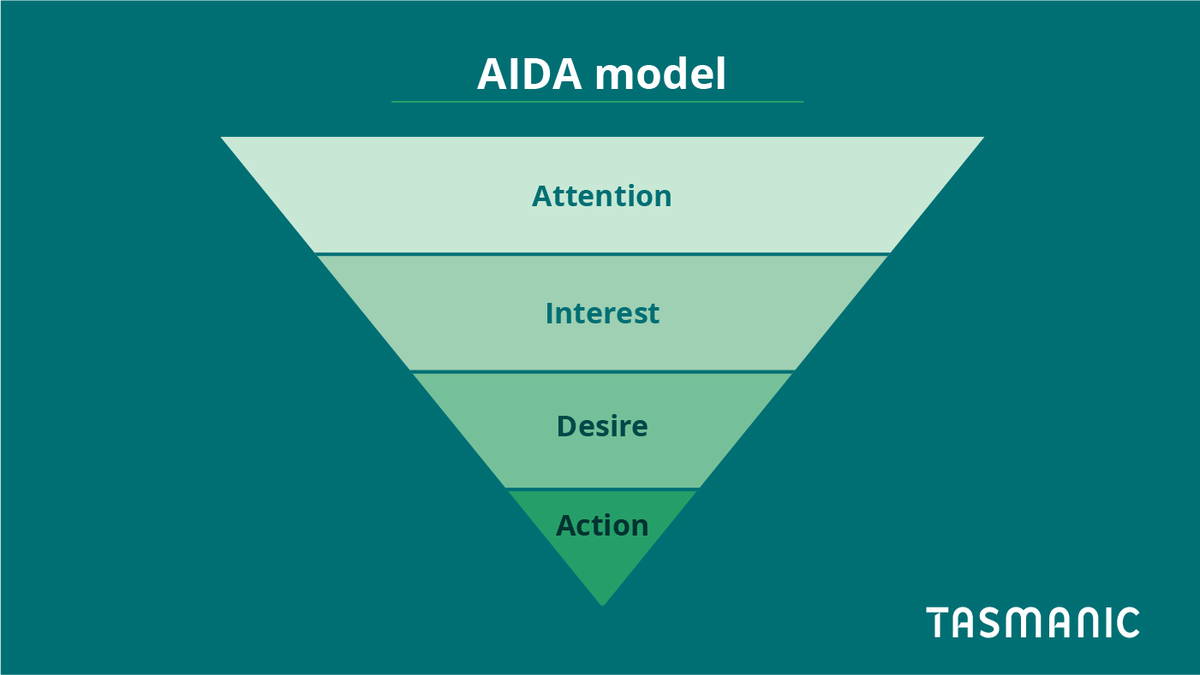
Introduction
The AIDA model is a classic marketing model in which you create an effective advertising campaign or sales strategy by following 4 steps. The model is simple and effective which is why it has been used by marketers for over 100 years for advertising, promotions and sales strategies. In this article we will tell you what the AIDA model is, explain the 4 steps and give practical examples.
What is the AIDA model?
The AIDA model is a marketing framework for creating advertising messages, ad campaigns and sales strategies consisting of 4 steps by which you guide customers through the buying process. AIDA is an abbreviation for Attention, Interest, Desire and Action. The AIDA model translates to Attention, Interest, Desire and Action.

The AIDA model is a linear model. This means that the 4 steps must be taken in order, so first you must grab the customer's attention, then arouse interest, then arouse desire, and finally drive the customer to action. You tailor the advertising message to the step the customer is in.
The AIDA method was introduced in 1925 by E.K. Strong who described it in his book The Psychology of Selling and Advertising. However, E.K. Strong is not the person who came up with this model. According to Strong himself and widely believed, the AIDA model was developed in the late 19th century by St Elmo Lewis.
AIDA model explanation
Let's discuss the four steps of the AIDA model in detail:
1. Attention (Attention)
This phase is all about grabbing the attention of the target audience. This can be done through eye-catching ads, catchy titles or visually appealing content. The goal is to stand out in an often crowded market.
Example:
- An ad with an eye-catching slogan or visually appealing design.
- Using a controversial or surprising image to arouse curiosity.
2. Interest (Interest)
Once you have captured their attention, you must generate interest by providing relevant and engaging information. This is where it's all about addressing the needs or problems of the target audience.
Example:
- A video showing how a product solves a specific problem.
- Sharing customer reviews or testimonials to build credibility.
3. Desire.
In this phase, you transform interest into desire. This means creating an emotional connection with the customer, highlighting the benefits of the product or service.
Example:
- Exclusive offers such as "50% off today only".
- Respond to FOMO (Fear of Missing Out) by emphasizing scarcity, such as "Only 3 left in stock!".
- Robert Cialdini's 7 principles of persuasion can be applied very well at this stage.
4. Action (Action).
The final stage focuses on converting desire into action. This is where you encourage the customer to actually make a purchase or perform some other desired action.
Example:
- A clear and eye-catching CTA (Call-to-Action), such as "Order Now!"
- Offer user-friendly check-out processes or a free trial.
AIDA model example
Let's take the promotion of a new coffee maker as a practical example of the AIDA model.
- Attention. An Instagram ad with a striking headline: "Say goodbye to boring mornings!" and an attractive image of a stylish coffee maker.
- Interest. When someone visits your product page you show a short video explaining how the device works and how it can improve your morning routine.
- Desire. A testimonial from a satisfied customer: "I can't live without this coffee maker anymore. It has completely changed my morning!"
- Action: A button with "Order now and get free coffee beans!"
AIDAS. The extension of the AIDA model
The AIDA model has been expanded and modified by economists over the years. For example, the model was recently modified to an AIDAS variant. In this, the S stands for Satisfaction. This addition emphasizes the importance of customer satisfaction after the purchase. By keeping customers satisfied, you increase the likelihood of retention, repeat purchases and word of mouth.
Criticism of the AIDA model
The AIDA marketing model is still widely used today. Yet it also has some criticisms.
- Linear process. The model assumes that customers always go through a linear process from attention to action. In reality, customers may regress to earlier stages or skip steps.
- The model also implies that one step activates the next step. In practice, however, this does not always work that way.
- Short-term focus. The model focuses primarily on immediate conversions and less on building long-term relationships with customers.
- Lack of finesse. While Desire implies emotion, it lacks depth to deeper psychological factors that influence buying behavior. However, you can overcome this by combining other models with the AIDA model. For example, we already wrote that Robert Cialdini's 7 principles of persuasion can be applied in the Desire step.
AIDA as a customer journey
The AIDA framework is also used by economists to represent the customer journey . Thus, each step in the AIDA model can be applied to a stage in the customer journey. The A of Attention is then often substituted for Awareness. AIDA can then also be seen as a funnel for the customer's buying process. To use the AIDA model as a customer journey, we recommend putting together buyer personas to better understand your target audience.
The AIDA model remains a powerful tool in marketing even after 100 years, mainly because of its simplicity and versatility. The model helps marketers create structured campaigns that respond to consumer needs and motivations. Although the model has its limitations, it can be a valuable tool for setting up for advertising campaigns.
Are the results from your online marketing disappointing?
Request our no-obligation performance scan and we'll tell you where you're going wrong.

















 Team
Team FAQ
FAQ Vacancies
Vacancies Contac
Contac AWR
AWR Ahrefs
Ahrefs Channable
Channable ContentKing
ContentKing Leadinfo
Leadinfo Optmyzr
Optmyzr Qooqie
Qooqie Hubspo
Hubspo Semrush
Semrush




